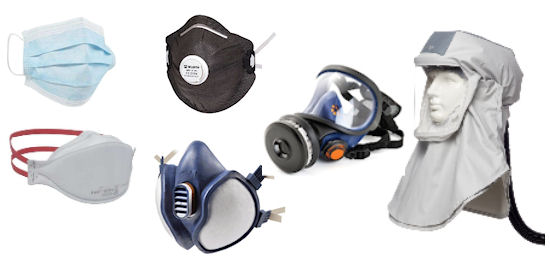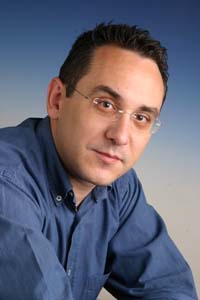Respiratory protective equipment, like all PPEs, are distinguished in many different types, each with its own sub-categories and specific uses and effectiveness.
Choosing the right mask depending on the use is very important as an inappropriate mask creates a false sense of protection and of course leaves the user exposed to the risk. It is also very important to confirm that the selected mask complies with the requirements of a specific standard and that this is clearly stated on the mask itself or on the package. Unfortunately, there are many single-use masks on the market that are available in a single package, and offer protection only slightly better than a piece of plain cloth.
Especially for disposable masks, the user should be aware that after the initial fixing and adjustment to the face, the mask should not be touched, but handled via its cords. Each mask, if used, should be considered contaminated by the agents it protects against (biological droplets, dust, etc.). As with almost all personal protective equipment, misuse is often just as dangerous as non-use.
The main types of respirators are as follows.
Face masks
These are disposable, loose-fitting masks, made of layers of non-woven material (most often polypropylene). They are usually folded to fit the face better and should be worn covering the mouth, nose and jaw. They are fixed with elastic cords behind the ears or behind the head. Their specifications must meet the requirements of EN 146683. Depending on the microclimate (temperature, humidity) they should not be used for more than a few hours.
They are distinguished in 3 sub-categories according to their effectiveness: BFE1, BFE2, R (from lowest to highest).
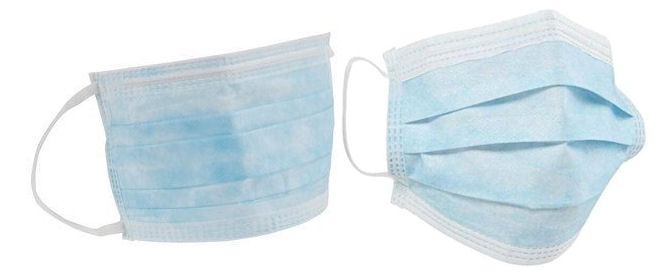
Simple face masks
They are used mainly by healthcare professionals mainly to protect the patients from droplets. They are also used by infectious patients to prevent dispersal. They provide a moderate degree of protection for the user from splashes and large droplets and are far less effective in protecting against small droplets and aerosols. In simple words, these masks are worn mainly by those who want to protect those around them and not by those who want to be protected.
Disposable respirators
These are disposable masks, with better fitting than face masks, but without being airtight. They are made with at least 3 layers of non-woven material and may have an exhalation valve. They are fixed with elastic cords behind the ears or behind the head and can have a small metal strip for better nose adjustment. Their specifications must meet the requirements of EN149. Gradual difficulty in breathing is an indication of saturation of the filter surface and signals the need for replacement. In any case, use should not be extended beyond one work shift. Replacement is also required when wet and visibly soiled.
Their main field of application is the protection against particles and droplets, while they provide no protection against volatile compounds and gases.
They are divided into 3 sub-categories:
FFP1: filtering capacity of at least 80%. Covers most non-hazardous dust protection applications (e.g. simple construction works, gardening)
FFP2 (corresponding to US N95 classification): filtering capacity of at least 94%. It is used in construction, industrial installations, agricultural works and by healthcare professionals for protection against influenza viruses, including SARS CoV-2. In the case of healthcare professionals it should also be combined with eye protection.
FFP3 (corresponding to US N99 classification): filtering capacity of at least 99%. It is used in the same activities as FFP2, in which case a higher level of protection is required due to the toxicity of the particles / droplets.
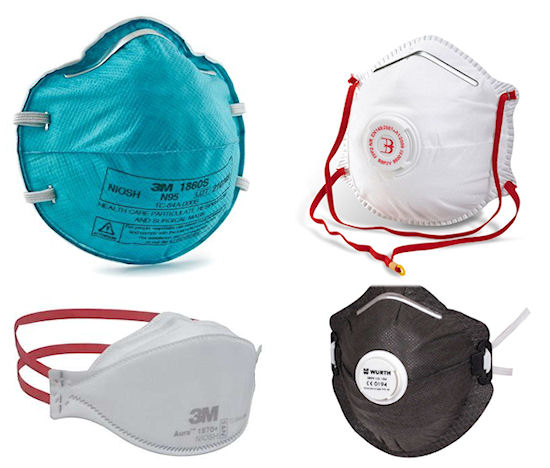
Indicative configurations of FFP2 (N95) respirators with or without exhalation valve. The blue mask is designated specifically for healthcare professionals. They all offer the same level of protection if used properly. They clearly state their classification (FFP2 or N95).
Disposable half-face respirators
These are sealing respirators that cover the nose and mouth and have built-in, non-replaceable filters. Their use is limited to the saturation time of filters or their wear by liquids, impurities or other factors, and in no case should it exceed 1 month. Their exact uses are determined by the coding of their filters (more detailed reference to the filter coding system can be found in the next paragraph), and as a rule they are effective against with very fine particles (e.g. asbestos), organic solvents and other toxic fumes, while they a filtration capacity of up to 99.8%. Their main uses are in construction work, in industrial facilities (paints, surface coating, shipyards, etc.), work with hazardous chemicals, agricultural work. As a rule, they must be combined with eye protection.
Their specifications must meet the requirements of the EN405 standard. Important information that is written on the mask or in its packaging is the coding of the filter, for example ABEK2P3, from which the scope of use can be determined
It should be noted that in case of use against very high toxicity or infectivity agents, they should be discarded immediately after a single use, regardless of the condition or degree of saturation of the filters, as it is not possible to clean them.
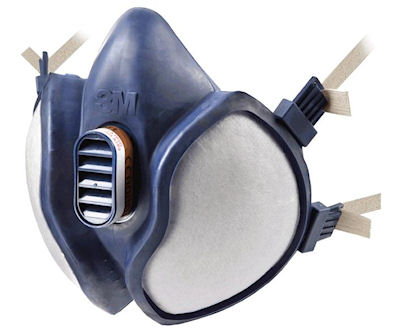
Half-face respirator with integrated ABE1P3 filters for protection against fine particles, organic vapors, inorganic and acid gases and ammonia
Half-face respirators with replaceable filters
They are masks that cover the nose and mouth tightly and have slots to which one or two replaceable filters are attached. The difference with the previous category is the option to replace the filters when they are saturated. Their exact uses are determined by the type of the selected filters and generally are the same as those described in the previous category, construction works, industrial facilities (paints, surface catings, shipyards, etc.), hazardous chemicals, agricultural work.
Their specifications must meet the requirements of EN140. Each manufacturer provides specific instructions and steps for cleaning the mask after each use, which usually include cleaning and disinfection with specific solutions of detergents and sodium hypochlorite.
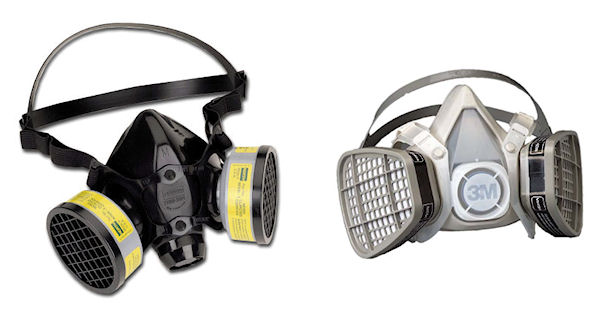
Half-face respirators with replaceable filters
The filters that are adapted to the masks (or are integrated in them, as in the previous type of masks) follow the specifications of the EN143877 standard. Depending on the scope of application, they have a specific alphanumeric code that designates them, as well as a specific color code (the two masks in the picture above show a yellow and a black stripe around the filter). The codes are interpreted as follows:
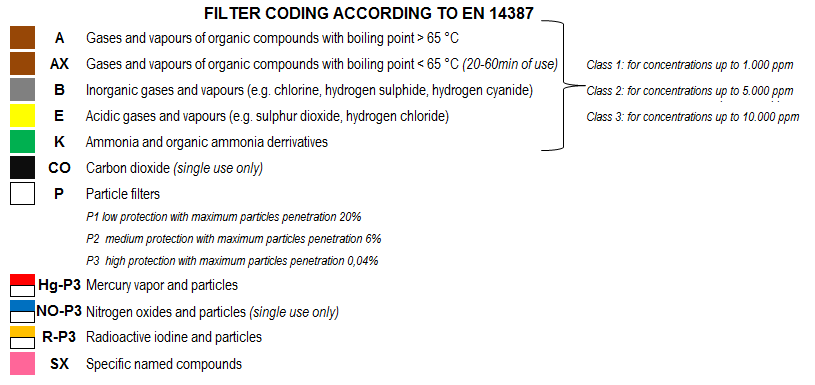
In addition to the individual filters, there are also combinations. For example, a filter with ABEK2P3 designation and color marking  is interpreted as providing protection against: gases and vapors of organic compounds with a boiling point > 65oC, gases and vapors of inorganic compounds, acidic gases and vapors, ammonia up to 5,000ppm and particles with a maximum penetration of 0.04%.
is interpreted as providing protection against: gases and vapors of organic compounds with a boiling point > 65oC, gases and vapors of inorganic compounds, acidic gases and vapors, ammonia up to 5,000ppm and particles with a maximum penetration of 0.04%.
Full face respirators
These are full-face, sealing masks that cover the entire face and have slots to which one or two consumable filters are attached. Many of the full face respirators can also be connected to an air supply device, being part of a self-contained breathing apparatus (SCBA).
Their main applications with the use of filters are in special works in which the combination of respiratory protection with face protection is chosen, public service agencies, while they provide, if the appropriate filter is used, brief protection for escaping from burning sites.
By using an air supply (SCBA), they are used in non-breathable atmospheres, for firefighting, accidents involving hazardous substances and specialized industrial applications.
Their specifications must meet the requirements of EN136. Each manufacturer provides specific instructions and steps for cleaning the mask after each use. It is also possible to increase the air induction through the filters by using a fan (further described in the following paragraph).
They are divided into 3 sub-categories:
Class 1, lightweight use-low maintenance requirements
Class 2, general purpose
Class 3, firefighting
Their use is recommended only by people who have received special training.
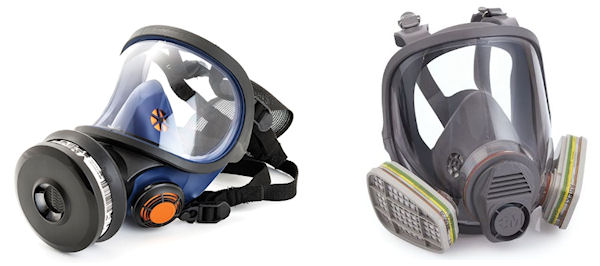
Indicative configurations of full face respirators
Powered, air-purifying respirators (PAPR)
Also referred to as positive-pressure masks, blower units, or just blowers, they consist of a fan that is powered by a portable battery and draws air from the environment by channeling it first to the filters selected according to the agents present, and then to the final breathing device which is usually:
> a full face mask like the ones described in the previous paragraph
> a head-to-shoulder positive pressure hood, (Racal uniform)
> a full-face mask-helmet combination
Special protection suits (HAZMAT, positive pressure suits) can use either a combination of PAPR with a full face mask, a self-contained breathing apparatus, or a fixed supply of fresh air (biological safety laboratories category 4 - BSL4).
The uses are extremely specialized and relate exclusively to special duty personnel after extensive training. They include, first responders to accidents involving high-toxicity dangerous substances, highly infectious diseases (e.g. Ebola virus), working in biological safety laboratories BSL3 and 4.
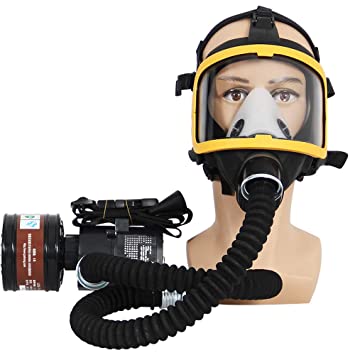
PARP combined with a full-face mask
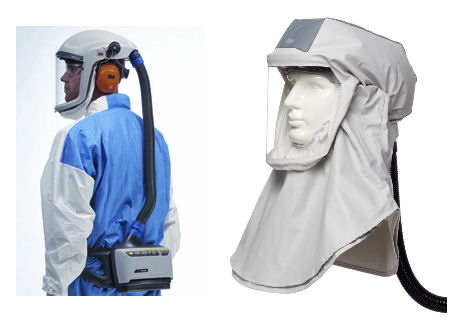
PARP full-face mask-helmet combination, PARP positive pressure hood
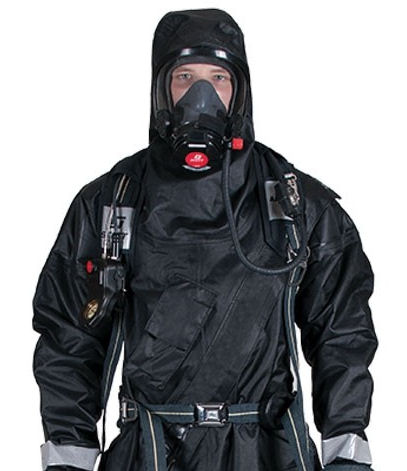
Level B HAZMAT suit with a self-contained breathing apparatus
Choosing a mask/respirator for a specific purpose should be the result of a process that includes the identification of risk factors/agents, establishing exposure limits for each of the risk factors and a complete risk assessment, and should not be a hasty and tentative choice. Many times using the wrong mask or the wrong filter can be more dangerous than not using it at all.




